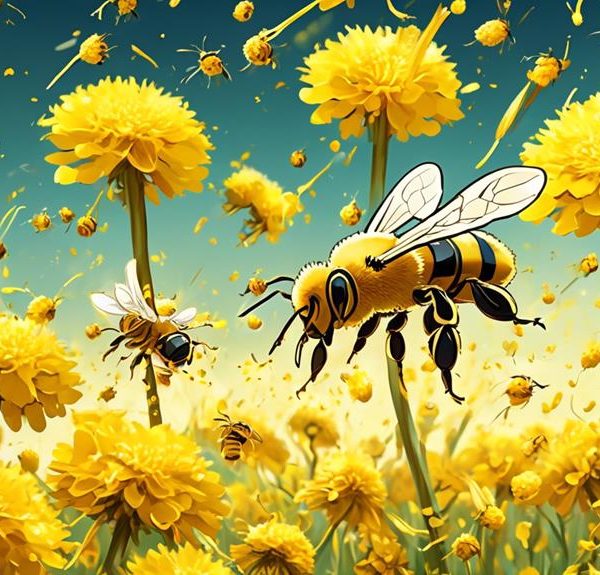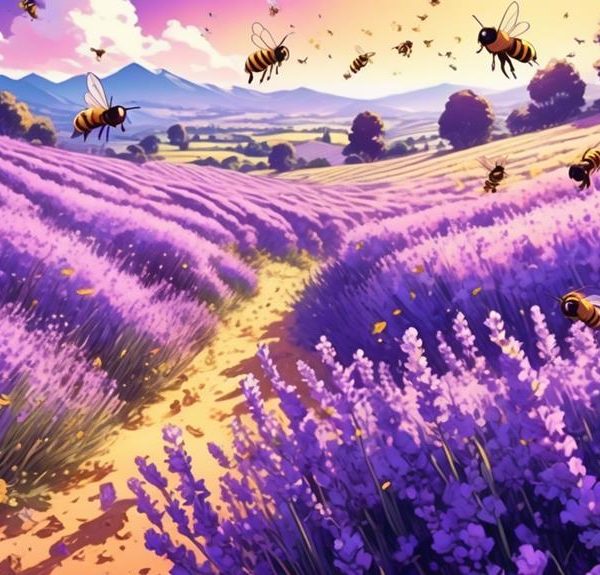Curious about why bees and butterflies are drawn to zinnias? Discover the fascinating reasons and how it can enhance your garden.
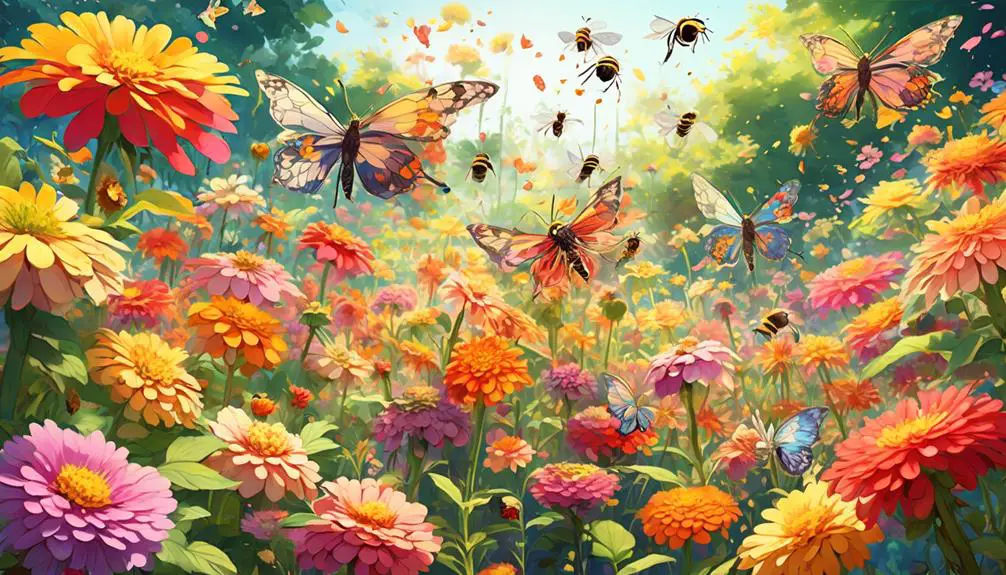
Do Bees and Butterflies Like Zinnias?
Imagine your garden teeming with the quiet hum of bees and the gentle flutter of butterflies, each drawn to the vibrant allure of zinnias scattered throughout. You've likely noticed that these captivating creatures seem particularly fond of these particular blooms, haven't you?
The question is, why does this preference occur? Do the bees and butterflies have a natural attraction to zinnias, or does it have more to do with the flower's unique characteristics?
As we explore this intriguing topic further, you might just find some unexpected insights for your own gardening practices.
Key Takeaways
- Zinnias are a high-quality food source for bees, providing abundant nectar and pollen.
- Zinnias' bright colors and large, flat blooms attract butterflies, serving as a visual cue for them.
- Zinnias' nectar is rich in sucrose, which is an essential energy source for butterflies.
- Compared to other flower types, zinnias offer a higher volume of nectar, easy landing platforms, and a vibrant array of colors that are highly visible to pollinators.
Understanding Zinnias: A Brief Overview
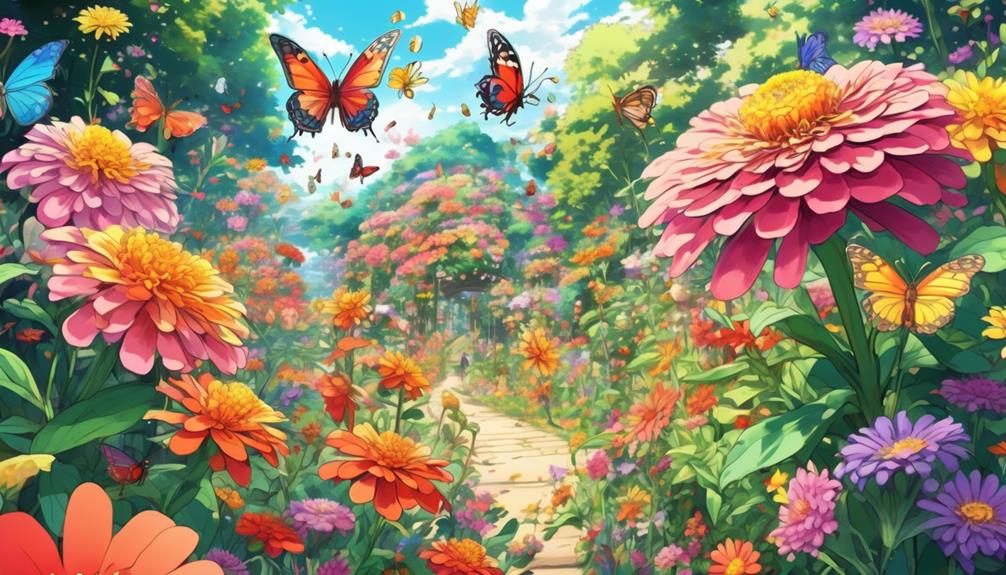
To fully comprehend the allure of zinnias to bees and butterflies, you'll first need to grasp the basic characteristics of these vibrant, hardy flowers. Zinnias, belonging to the Asteraceae family, are annual plants known for their bright, daisy-like blooms. They're native to the scrubby, dry grasslands of the Southwestern United States, Mexico, and Central America, which explains their incredible drought resistance.
You'll notice that zinnias have a wide range of hues, from red, pink, and purple, to yellow, orange, and white. This diversity in color isn't just for show; it's a strategic adaptation for attracting pollinators. Moreover, zinnias are composite flowers, meaning they possess numerous small flowers, called florets, clustered together. Each floret is capable of producing nectar, making zinnias a rich feeding station for bees and butterflies.
Additionally, zinnias have a relatively long blooming period, typically from early summer to the first frost. This extended availability of nectar is another significant factor in their allure to pollinators.
In essence, understanding the resilience, color diversity, composite structure, and long blooming period of zinnias can help you appreciate why they're such a magnet for bees and butterflies.
Nutritional Benefits of Zinnias for Bees
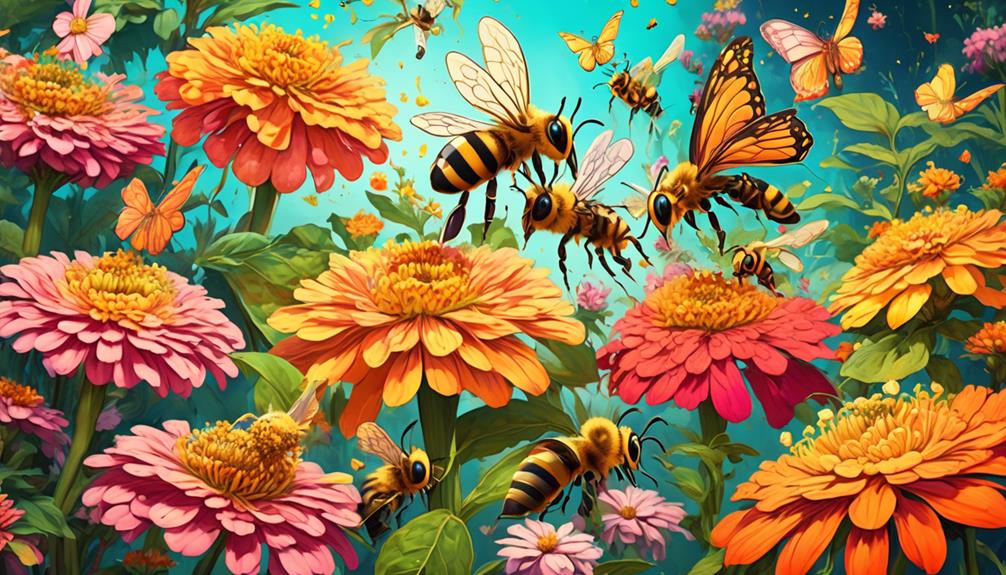
Building on the irresistible allure of zinnias for bees, let's explore the specific nutritional rewards these vibrant flowers provide for these crucial pollinators.
Zinnias, with their abundant nectar and pollen, are a high-quality food source for bees.
The primary nutritional gain for bees from zinnias is the nectar, which is rich in sugars. These sugars are a bee's primary energy source, fuelling their flight and general activity. Meanwhile, the pollen provides bees with a protein source, necessary for growth and reproduction.
Zinnias' nectar also contains essential amino acids, which support bee health and immune function. On top of this, the nectar and pollen have trace amounts of vitamins, minerals, and antioxidants that can contribute to the overall well-being of bees.
It's also worth noting that zinnias bloom for a long period, providing a consistent food source when other blooms might be scarce. As a beekeeper, you'll appreciate this aspect as it supports bee colony health and survival.
Zinnias and Their Attraction to Butterflies
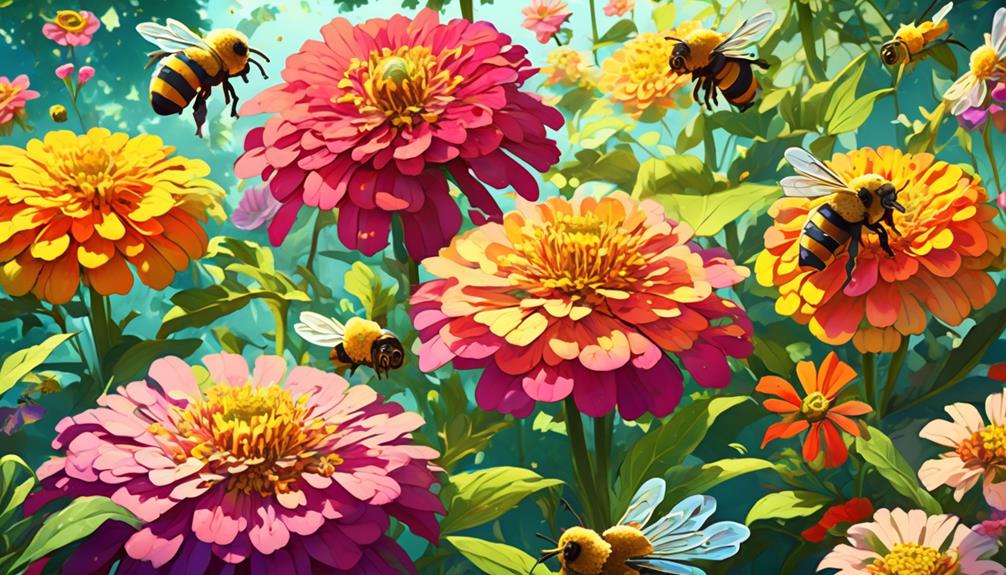
Just as bees, butterflies are irresistibly drawn to zinnias, attracted by their vibrant colors and the rich nectar they provide. But why is this attraction so strong, you might ask? It's due to a combination of factors that make zinnias a butterfly magnet.
Primarily, zinnias' bright colors and large, flat blooms act as a visual cue for butterflies, signaling a ready source of food. The color spectrum of zinnias, ranging from warm yellows and oranges to rich reds and purples, is particularly appealing to butterflies, who possess color vision. These vivid hues function like a neon sign, advertising nectar-rich flowers to passing butterflies.
Additionally, the nectar of zinnias is high in sucrose, a type of sugar that butterflies need for energy. Butterflies, like humans, require a balanced diet, and the sucrose found in zinnias' nectar provides them with the necessary calories for flight and reproduction.
Furthermore, the physical structure of zinnias, with their large, flat petals, provides an ideal landing platform for butterflies. This allows them to feed comfortably, further enhancing the attractiveness of these flowers.
Comparing Zinnias to Other Flower Types
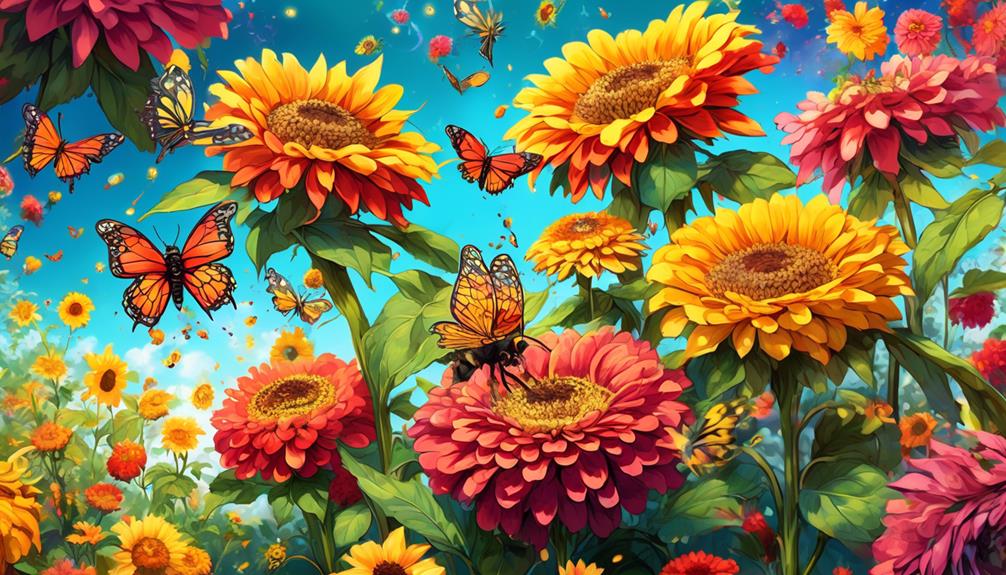
When you compare zinnias to other flower types, such as roses or sunflowers, you'll notice distinct advantages that make them a top choice for attracting pollinators. Zinnias produce a higher volume of nectar, which is a primary food source for bees and butterflies. Their flat, open blooms also provide an easy landing platform for these creatures, unlike the intricate folds of roses or the towering heights of sunflowers.
Furthermore, the bright, bold hues of zinnias are highly visible to pollinators. Bees, in particular, are drawn to the yellow and blue spectrum, while butterflies prefer red and purple. Zinnias offer a vibrant array of these colours, ensuring they attract a wide variety of pollinators.
In contrast, roses and sunflowers, while beautiful, don't offer the same advantages. Roses' complex petal arrangements can deter some pollinators, and their nectar isn't as readily accessible. Sunflowers, although they produce ample nectar, can be a challenge for smaller pollinators to navigate due to their height and large, dense flower heads.
Enhancing Your Garden for Pollinators
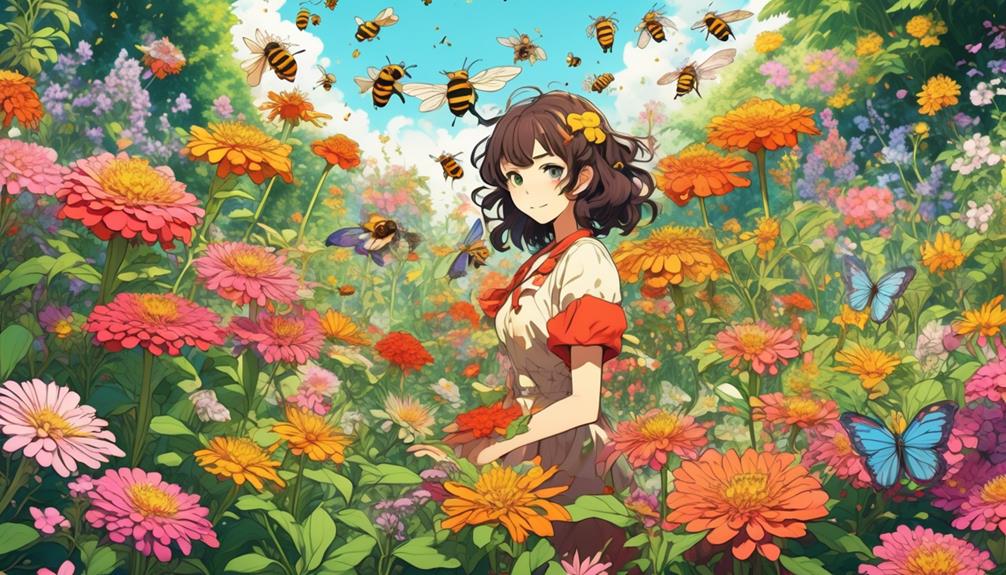
Understanding the unique appeal of zinnias to pollinators, you can leverage these attributes to craft a garden that's a veritable magnet for bees and butterflies. Start by selecting zinnia varieties with vibrant colors and open petal structure, which are more inviting to these creatures.
Consider the following table:
Zinnia Attribute | Pollinator Benefit |
|---|---|
Vibrant Colors | Attracts bees and butterflies from afar |
Open Petal Structure | Allows easy access to nectar |
Continual Blooming | Provides consistent food source |
Variety of Heights | Appeals to different species' preferences |
Planting a variety of zinnia heights can accommodate different species' preferences, while continual blooming ensures a consistent food source.
In addition to zinnias, diversify your garden with other pollinator-friendly plants to provide a varied diet. Include nectar and pollen-rich plants, as well as plants that serve as host species for butterfly larvae.
Lastly, avoid pesticides. They're harmful to pollinators and can counteract your efforts. Instead, opt for natural pest control methods.
Frequently Asked Questions
How Do Bees and Butterflies Contribute to the Pollination Process of Zinnias?
You mightn't know it, but bees and butterflies play a crucial role in zinnia pollination. They're attracted to the vibrant colors and sweet nectar of these flowers. As they move from bloom to bloom, they inadvertently collect pollen on their bodies, which gets transferred to other flowers.
This cross-pollination ensures the survival and propagation of zinnias. So, they're not just enjoying a meal, they're also playing a key part in the lifecycle of these plants.
What Other Insects Are Attracted to Zinnias Besides Bees and Butterflies?
Aside from bees and butterflies, you'll find several other insects attracted to zinnias. Moths, hoverflies, and beetles are often spotted around these vibrant flowers. They're drawn to the nectar and pollen, just like bees and butterflies.
However, don't forget about hummingbirds! Though not an insect, they're also big fans of zinnias.
It's a bustling ecosystem right in your own garden!
Are There Any Specific Varieties of Zinnias That Are More Attractive to Bees and Butterflies Than Others?
Yes, there are specific zinnia varieties that bees and butterflies prefer. They're particularly drawn to single-flowering zinnias, such as the 'Star' or 'Crystal' series. These types present their pollen more openly than double-flowering varieties, making it easier for pollinators to access.
You'll notice bees and butterflies flocking to your garden if you plant these zinnia varieties. Keep in mind, plant diversity also plays a role in attracting a variety of insect life.
Do Zinnias Have Any Defensive Mechanisms Against Pests or Insects That May Harm Them?
Yes, zinnias do have defensive mechanisms against harmful pests and insects. They produce a chemical called sesquiterpene lactone, which acts as a natural insecticide. It's toxic to many insect species, deterring them from feeding on the plant.
However, this doesn't affect bees and butterflies, so they're still attracted to the zinnias' vibrant colors and sweet nectar. It's a clever way zinnias protect themselves while still attracting pollinators.
Can Zinnias Survive in a Variety of Climates and Soil Types, Making Them Suitable for Diverse Gardening Environments?
Yes, you'll find zinnias are highly adaptable and can thrive in a variety of climates and soil types. They're heat and drought tolerant, making them suitable for arid regions. However, they also do well in temperate zones.
As for soil, they're not picky, but they do best in well-draining, fertile ground.
Conclusion
You've seen that zinnias offer substantial benefits to bees and butterflies. They're nutritionally rich, attractive, and compare favorably to other flowers. Enhancing your garden with zinnias not only adds vibrant color, but also supports these crucial pollinators.
Remember, maintaining a bee and butterfly-friendly garden contributes to a healthier environment. So, go ahead, plant some zinnias. You'll be doing your part for our buzzing and fluttering friends, and adding a touch of beauty to your green space.

